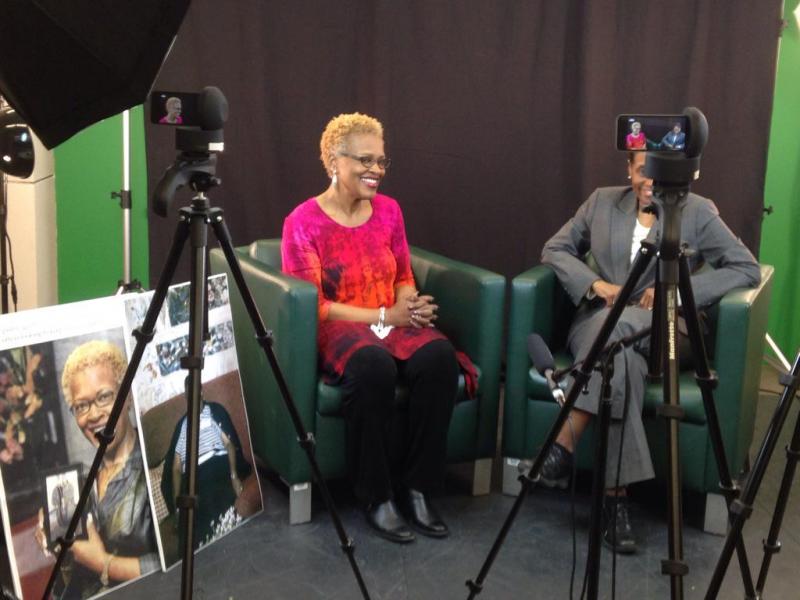Akronist: TV-quality studio video from mobile devices
Think you need a lot of costly equipment or space to build a TV studio? Think again. The Akronist assembled their TV studio for just under $3000, relying heavily on consumer-level mobile technology and space at the public library.
Akronist TV is an online video series where residents of greater Akron, Ohio discuss topics from vegan cooking to homelessness and community building.
To create a studio that anyone could be trained to use, and also to make the most of limited resources, the Akronist (a Knight-supported community site) decided to rely heavily on consumer-grade mobile devices: iPads and iPods, with tripod and lens attachments, lighting, microphones and several user-friendly media production apps.
"We wanted to remove barriers, so people to come in and quickly learn via touchscreen how to make a TV show. When they can use easy, familiar technology, that helps them focus on what's important, the content," said Chris Miller, Community Investment Officer for the Akron Community Foundation. "I didn't think this would be possible, but the app developers especially have been adapting to consumer media creation needs, and that makes a huge difference."
Miller teamed with local filmmaker and media producer Blue Green to build a TV studio in a small space in the basement of the Akron Public Library. "The hard part was building and painting stage and green screen," said Miller.
The studio is designed as a standard three-camera setup, supporting a medium shot plus closeups on two people. Apple mobile devices are the backbone: one iPad and four iPods. The iPad serves as the control center switcher, and the iPods are the cameras. Switcher Studio Basic is the app used to control the cameras.

"There's really not much involved," said Miller. "The real trickery is in the switching device, executing camera angles and dissolves. And we run sound directly into the iPad from a shotgun microphone."
The studio gear also includes a robotic tripod head -- basically, a ball that sits on top of a plate, which mounts on a conventional tripod, allowing the camera position to be controlled by remote from the iPad via a Bluetooth connection. Also, clip-on wide-angle lenses go a long way toward creating a professional video look.
That, plus some basic lighting and microphones, and a pay-as-you-go mobile hotspot, batteries and cables, and you have a TV studio. All of the mobile devices can be packed into a suitcase for on-location shoots. (Full equipment list at the end of this post.)
The Akronist holds open workshops, where community members pitch show ideas. They help people develop their ideas, and bring the most developed ideas into the studio for training and shooting.
Typical shows are 10-15 minutes long. A few videos are released each week. In such a small space, the two-person interview format works well and allows for minimal post-production editing.
"We've learned a lot through trial and error," said Miller. "We've learned it's important to get an iPad with the maximum possible storage. Also, some apps work better for live streaming shoots, others for uploading later. We've done some live shoots at events. That's still rocky, but we're working it out."
Expanding more into event coverage offers greater opportunities for community participation via their own phones. "People going to the event can download free Switcher Studio Pro app, and then volunteer to be camera people for the event," said Miller. "Then after the shoot, our iPad pulls in video from local devices."
Looking ahead toward financial sustainability, the TV studio offers revenue potential. "In the next year we'll probably integrate studio time as a library service -- probably charging $50 for one hour to shoot a 15-minute show, videos for Kickstarter campaigns, etc. We also can do marketing videos for local nonprofits at a low cost. And we could create an equipment package to offer a TV studio in a box to local schools or organizations."
Taking the "fear factor" out of media production, to show people how easy it can be, is an empowering experience for community members. And learning in the controlled environment of a studio tends to be less confusing and more focused than in-the-field training. "People just love this stuff," said Miller. "It can be a surprising amount of fun."
Akronist TV studio equipment:
Hardware: about $2900 total cost
- Controller: One iPad 128 GB ($499, but current models cost more)
- Cameras: Four iPod 5th generation, 16 GB. ($188 each)
- Tripods: Three Manfrotto lightweight tripods ($60 each)
- Camera mount: One Galileo Motrr Bluetooth tripod head ($150)
- Stabilizers: Two Steadicam Smoothees ($140 each)
- Wide-angle lenses: Two Olloclip 3-in-1 lenses ($70 each)
- Microphones: One iRig Mic cast ($35), one boom mic and cable ($200), one boom mic stand ($20)
- Lighting: One light kit, four pro lights ($400)
- Power: Three Mophie powerstations ($53 each), plus two power strips with USB ports ($14 each)
- Wireless connectivity. One mobile hotspot card ($60), with a pay-as-you-go mobile data plan ($50/month for 5 GB refill cards)
Software:
- Video recording: RecoLive ($4.99/month)
- Switching: Switcher Studio Basic (free)



